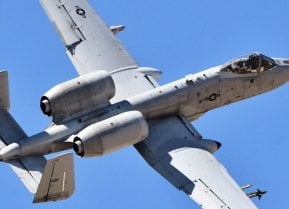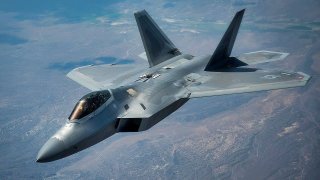How the Eurofighter Typhoon 'Shot Down' An F-22 Raptor and We Should Not Worry
Despite its formidable reputation, the F-22 Raptor has faced challenges in simulated dogfights, notably against older jets and the German Eurofighter Typhoons about a decade ago, tarnishing its invincible image.
And that, combined with its improved avionics and beyond-visual range capabilities that have manifested since that interaction, make the Eurofighter Typhoon one of the best pound-for-pound fighters anywhere on the planet.
Its foreign-sales price is, after all, right around $124 million – which is an incredible bargain compared to the estimated $400 million or so per Raptor, at least, when you include its research and development costs in each F-22’s price tag.
Even if Raptors did score more kills against Typhoons than the Germans did against Raptors as a number of sources have reported, the fact that the 4th generation Eurofighter was a genuine threat to the F-22 at all proves that its supremacy isn’t as assured as so many Raptor fanboys like to believe.
BUT THE TRUTH IS…
Both of these arguments are right. The F-22 Raptor isn’t considered the most dominant air superiority fighter in the sky because it can’t lose. That’s not how combat works — heck, it’s not how any kind of fighting works. No matter how capable, no matter how advanced, no matter how well trained, anyone can find themselves knee-deep in a disadvantage they can’t overcome.
Eric Wicklund, a former Operations Specialist in the U.S. Navy, made this point rather eloquently earlier this year:
“World War II ace, Erich Hartmann is the highest scoring ace, ever, with 352 kills. That doesn’t mean he never lost. He got shot down 16 times! He’s still the greatest ace, because he won much more often than he lost.”
The F-22’s advanced avionics, high degree of maneuverability, and extremely low observability all make it an incredibly capable platform, but nothing makes a fighter invincible. If you stack the deck against anything, it’ll find its limits – and it’s important to note that finding those limits, of both the pilot and the platform, is the real reason these exercises exist.
Red Flag isn’t about winning internet dog fights, it’s about going on to win real ones. Taking home a few W’s in a series of staged exercises doesn’t mean nothing, but it doesn’t mean everything either.
The truth is, the Eurofighter Typhoon is an incredibly capable 4th generation fighter, but when you pit it against a 5th generation fighter, that stealthy opponent – be it F-22, F-35, or maybe even J-20 – is likely going to win most engagements in a relatively boring (and rather sneaky) way.
But if these stealth jets happen to find themselves within gun’s reach of the Eurofighter, the victor isn’t as easy to divine. And that’s an important lesson for both 4th and 5th generation pilots to take away from these exercises.
This assertion is substantiated in numbers we can confirm: in its earliest appearances at Red Flag back in 2006 and 2007, F-22s racked up 144 and 241 wins respectively, but lost a handful of jets as well to lowly 4th generation fighters like the F-16C – which was the first platform ever to down an F-22. in a mock dogfight. In fact, in the F-22’s first air-to-air outing (without being limited to within visual range), it took out eight F-15s without them ever managing to paint it with a target.
But… if you can get in close with the F-22 and eliminate its technological advantages, the Raptor is just another aircraft in a fight for its life.
“The Raptor’s unique capabilities are overwhelming, but as soon as you get to the merge, which is [admittedly] only a very small spectrum of air combat, the Typhoon doesn’t necessarily have to fear the F-22 in all aspects. We gain energy better than the F-22 when we are slow, for example,” Fighter Wing 74 commander Col. Andreas Pfeiffer said of the mock engagements.
This all reminds me of something an American intelligence contractor told me years ago about U.S. special operations units. They’re the most elite operators in the world with the best training, the best equipment, and the best support… but just about every Navy SEAL, Delta operator, or Army Ranger who’s been killed in combat over the past two decades wasn’t taken down by a similarly elite group of ISIS or Al-Qaeda commandos. More often than not, it’s a poorly trained young man with a poorly maintained AK-47, no body armor, and some luck on his side.
You can give your warfighters all the advantages in the world, but nobody knows how a fight will play out until it does. In fact, according to Air Force Col. Thomas Bergeson, in Red Flag exercises, “you have a great day if you lose only 10 percent of your forces.” And he’s not alone.
“If you see numbers where you never have a loss, I don’t think you’re training to your full ability,” explained Lt. Col. Wade Tolliver, 27th FS commander, back in 2007. “If you don’t, at some point, have that simulated loss, we’re not going to push ourselves to be as capable as we are.”
That’s the unfortunate reality of defense technology analysis. The real answer is rarely pithy, rarely simple, and rarely can stand on its own without some broader context. The internet prefers that we speak in concise absolutes, but the only incisive answer you can really give when asked which out of two contemporary platforms is best is… it depends.
It depends on the mission, the circumstances, the rules of engagement, the pilots, the mission planning, the training, the budget, the over-arching combat doctrine, and if any of the pilots had two extra cups of coffee this morning and is distracted by the pressing need to find a toilet.
“No matter how magical the F-22, any pilot can make a mistake, explained Air Force Lt. Col. Dirk Smith in 2007. “The beauty of Red Flag is that we were able to go out and practice our tactics in a challenging scenario, make a mistake, learn a lesson, and be that much better prepared for actual combat.”
SO WHAT’S THE VERDICT BETWEEN THE F-22 RAPTOR AND EUROFIGHTER TYPHOON?
Can the Eurofighter Typhoon beat the F-22 Raptor in a dogfight? The answer is an unequivocal yes. It’s a very capable jet and, under the right set of rare and unusual circumstances, just about anything could beat the F-22. In fact, if you were really impressed by the F-22 kill markings on those Typhoons, you should know that they’ve been applied to other aircraft after notional victories… including at least one A-10 Warthog (alongside another mark for an F-16 kill).
But are F-22 pilots losing sleep over this? The answer there is no.
“When the sensors work and each plane talks to each other, the Raptor is nearly untouchable when things are right,” F-22 pilot Mike ‘Dozer’ Shower said in Bertie Simmonds” book, F-15 Eagle.
“The F-22 versus a 4th-generation fighter is like having two football teams against each other and one of them [the F-22] is invisible!”
People don’t call the F-22 Raptor the reigning king of the skies because it never loses. Having the F-22 Raptor on your wing in the sky, like Micheal Jordan on the basketball court or Chesty Puller on the battlefield, isn’t a guarantee of victory. They all have a few L’s on their resumes.
Nobody wins all the time. Not even the mighty Raptor.
About the Author
Alex Hollings is the editor of the Sandboxx blog and a former U.S. Marine that writes about defense policy and technology. He lives with his wife and daughter in Georgia.


